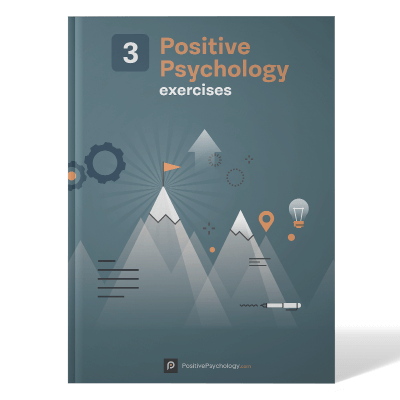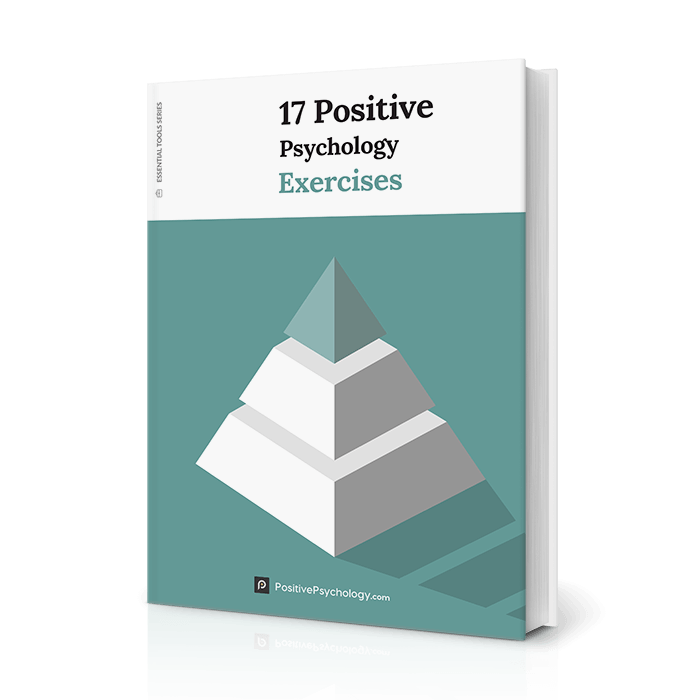What Is Negativity Bias and How Can It Be Overcome?
 Do you sometimes feel stuck thinking about unpleasant encounters you’ve had or setbacks you’ve endured?
Do you sometimes feel stuck thinking about unpleasant encounters you’ve had or setbacks you’ve endured?
When you read the news, do you find yourself drawn to the more depressing articles? As humans, we tend to be impacted much more by negative events than by positive ones.
This negativity bias can influence how we feel, think, and act, and can have some less-than-desirable effects on our psychological state. So what does it look like, and how can we overcome it? Read on to find out.
But first, we thought you might like to download our three Positive Psychology Exercises for free. These science-based exercises explore fundamental aspects of positive psychology, including strengths, values, and self-compassion, and will give you the tools to enhance the wellbeing of your clients, students, or employees.
This Article Contains:
What Is Negativity Bias?
Negativity bias refers to our proclivity to “attend to, learn from, and use negative information far more than positive information” (Vaish, Grossmann, & Woodward, 2008, p. 383). We can think of it as an asymmetry in how we process negative and positive occurrences to understand our world, one in which “negative events elicit more rapid and more prominent responses than non-negative events” (Carretié, Mercado, Tapia, & Hinojosa., 2001, p. 75).
Among other things, it can explain why we often:
- Recall and think about insults more than compliments
- Respond more – emotionally and physically – to aversive stimuli
- Dwell on unpleasant or traumatic events more than pleasant ones
- Focus our attention more quickly on negative rather than positive information
Even when we experience numerous good events in one day, negativity bias can cause us to focus on the sole bad thing that occurred. It can lead us to ruminate on small things, worry over having made a bad impression, and linger on negative comments (Lupfer, Weeks, & Dupuis, 2000; Chen & Lurie, 2013; Wisco, Gilbert, & Marroquín, 2014).
Where does this bias come from? Can we learn to spot examples of negativity bias in real life? And how can we avoid falling into the trap of getting caught up by negative events?
Where does it come from?
Negativity bias is thought to be an adaptive evolutionary function (Cacioppo & Berntson, 1999; Vaish et al., 2008; Norman et al., 2011). Thousands of years ago, our ancestors were exposed to immediate environmental threats that we no longer need to worry about – predators, for example – and being more attentive to these negative stimuli played a useful role in survival.
These days, the bias may play a role in our early development. As Vaish et al. (2008, p. 18) point out, infants don’t have extensive life experience to draw on: “the earlier an organism learns that it should avoid those stimuli that its conspecifics find aversive, the better are its chances for survival.”
Negativity bias helps them avoid potentially harmful stimuli in the absence of learned information about ambiguous stimuli.
It’s hard to argue that a negative bias isn’t still helpful in some circumstances, but as we grow and society develops, this hardwired tendency is not as useful as it once was.
3 Examples of Negativity Bias
Several studies illustrate how this asymmetry affects our attention and cognitive processes on a day-to-day basis.
We respond more to negative stimuli
Ito, Larsen, Smith, and Cacioppo (1998) found that our brains respond more intensely to negative stimuli. The researchers presented photos to 33 participants and measured their brain’s electrical activity to study its responses.
Some were affectively neutral (an electrical outlet, a plate), some were considered positive pictures (people enjoying a rollercoaster), and some were deemed negative images (a gun pointed at the camera, a mutilated face).
Findings showed more event-related brain potentials (ERPs), or activity, when participants viewed negative, as opposed to positive images, leading the researchers to conclude that our evaluations are more strongly influenced by the former.
News coverage is predominantly negative
Around the world, negative news articles appear to dominate the media, but why are they so prevalent? One hypothesis is that due to negativity bias, negative coverage is more attention grabbing than positive coverage. This is a logical inference from the study results we just described (and many more), but is it actually the case?
Soroka, Fournier, and Nir (2019) looked into whether demand for negative information is a cross-national phenomenon. Examining people’s psychophysiological reactions to video news content in 17 countries, their results revealed that, globally, humans are more aroused by and attentive to negative news on average.
We think about negative events more
Have you ever been hung up on something terrible that happened earlier in the week, despite everything else going great? Our tendency to think more about negative events is another example of this bias in action. Larsen (2009) reviewed ample evidence to suggest that negative emotions last longer than positive ones, that we tend to spend more time thinking about negative events, and that we often reason about them more.
This is likely related to learning and memory processes. The more attention we give to a stimulus or experience, the higher the likelihood that we’ll commit it to memory (Ohira, Winton, & Oyama, 1998).
Can you think of more examples of negativity bias in action?
How to Overcome the Bias
As we’ve seen, negativity bias is very much concerned with where we direct our attention. By directing more of our conscious attention toward the positive events and feelings we experience, we can begin to address the asymmetry of negativity bias.
And that requires practice. So, where do we start?
Self-awareness and challenging negative self-talk
By checking in with yourself throughout the day, you can start to recognize any thoughts that are running through your mind – both helpful and unhelpful ones. You can also look at your own behaviors too, for a better understanding of what’s serving you and what isn’t.
From here, you can start to tackle these head on, challenging them and replacing them with more useful ones. Albert Ellis’s (1957) ABC technique is one useful framework you can apply here. Once you become aware of your behavior or its consequences (B and C in the model, respectively), then you can work backward to think about what led to them (A for antecedents).
What were you thinking before experiencing anger, resentment, or frustration? Was it negativity bias in action, perhaps? And how can you replace those thoughts with more positive ones?
Mindfulness: Breathing, meditations, and more
Practicing mindfulness is one good way to become more attuned to your own emotions (Charoensukmongkol, 2014). Through guided meditations, reflection, and other mindfulness interventions, you can start to observe your feelings and thoughts more objectively.
Even more promising evidence comes from a 2011 study from Kiken and Shook, who found an increase in positive judgments and higher levels of optimism when participants practiced mindful breathing.
Compared to control groups, these participants performed better at tests where they were required to categorize positive stimuli, leading the researchers to suggest that mindfulness practice can have a significant positive impact on the bias (Kiken & Shook, 2011).
Cognitive restructuring
Negativity biases have been linked to numerous psychological disorders, such as depression and anxiety (Riskind, 1997). When you catch yourself taking a negative view of situations, it may help to practice cognitive restructuring by reframing the event or experience.
We have plenty of free PDF Cognitive-Behavioral Therapy worksheets that can help you to get a more objective view of situations and people so you can work toward overcoming your negativity bias.
Savor the positive moments
When you stop and take some time to drink in a positive experience, you’re savoring it and creating memories for the future (Bryant & Veroff, 2017). Building up your store of positive mental images and feelings can help you address the imbalance that negativity bias predisposes us to.
The next time you experience or create a positive moment, take a little longer than you usually would to enjoy it. Engage fully in the good sensations, happy thoughts, and pleasant emotions that you feel and make a note of what you enjoyed about it. When you go home, why not reflect on what just happened and turn the savoring skill into a habit?
3 Exercises for overcoming negativity bias
We’ve got a few great exercises and interventions in our blog and toolkit to help you start overcoming your negativity bias.
- This The What If Bias intervention can be used one-on-one settings. Its goal is to help you adapt your view of negative experiences or events by taking a more balanced and positive perspective on them. Instead of catastrophizing possible negative outcomes, positive outcomes are envisioned.
- ACT Defusion Metaphors is a worksheet applicable to Acceptance and Commitment Therapy, where our habituated thought patterns are questioned. When a thought arises, it must be evaluated with this series of questions. It encourages separation from negative thinking and includes helpful illustrations of how we should see our negative thoughts.
- With this Fun Mindful Eating exercise, you can learn how to appreciate micro-moments of positivity in your life. Although this exercise is aimed at children, it is a great way to take a small step towards focusing on the positive. Savor the present moment, savor a meal and then take further steps toward addressing the positive–negative asymmetry we’ve been discussing.
3 Useful Tests
Negativity bias can be studied using a variety of different subjective and psychophysiological tests. If you’re interested in researching the phenomenon further, here are a few approaches that have been used in peer-reviewed studies:
- The Future Events Scale is a subjective, 26-item measure of negativity bias that measures optimism and pessimism on two separate subscales (Anderson, 1990). To complete this test, subjects use an 11-point Likert scale to rate how likely or unlikely an event is to take place in the future, with +5 being extremely likely and -5 being extremely unlikely. The more pessimistic a subject’s score, the higher their negativity bias (Kiken & Shook, 2011).
- ERP measures are a psychophysiological way to study the bias, coupled with affective processing tasks (Ho, Sun, Ting, Chan, & Lee, 2015). Typically in such studies, participants are asked to sort or rate stimuli such as words or pictures according to their emotional valence; in the meantime, measures of their electrophysiological responses are made.
- The online WebNeuro battery also includes self-report items that can be used to assess an attributional bias toward expecting and perceiving negative results and events (Rowe et al., 2007; Williams et al., 2008). This and other negativity bias tests are discussed more thoroughly in Williams et al.’s 2009 study, which is mentioned below.
What Are Dominance and Contagion?
Rozin and Royzman (2001) conducted one of the best-known early studies on the phenomenon. In it, they unpack the concept and four ways in which it manifests:
- Negative potency describes the idea that positive and negative entities (e.g., events, things, or experiences) hold different importance to us, regardless of whether they are equal in size or emotionality.
- Steeper negative gradients refer to the phenomenon whereby the negativity of ‘bad’ events increases faster when they grow closer to us.
- Negativity dominance describes how “combinations of negative and positive entities yield evaluations that are more negative than the algebraic sum of individual subjective valences would predict” (Rozin & Royzman, p. 296).
- Negative differentiation refers to the notion that our conceptual representations of negative entities are more complex and stimulate a broader array of responses from us.
Imagine a day in which five good things happen to you, but then you step in a puddle and ruin your shoes. If you were to consider your day ruined – negativity bias – this would be an example of negativity dominance.
Contagion, on the other hand, refers to the idea that “negative events may have more penetrance or contagiousness than positive events” (Rozin & Royzman, 2001, p. 306). And the authors give some great examples; we won’t very willingly eat food that’s been even fleetingly touched by worms, for one.
You can read their influential paper here.
The Bias in Relationships
We know that negativity bias impacts our impressions of other people, our decision-making, and our attention. As such, it can impact our relationships with others in several ways.
Among others:
- It can lead us to assume the worst about people we don’t yet know. Our beliefs and expectations can then influence our subsequent interactions with them (Glover, Pallais, & Pariente, 2017).
- By making pessimistic assumptions about how another person will react, we can also fall into the trap of letting our (unwarranted) attitudes impact our behaviors.
- As with the negative potency concept, the bias can lead us to interpret negative events as more important than positive ones. We can view someone’s slip-up as highly salient compared to their positive behaviors, leading us to ruminate over them to the detriment of our relationships.
Recognizing how the negativity bias works is the first step to overcoming its potential negative impacts on our relationships. Through self-awareness and excellent communication, we can start looking for the positive in our interactions and the people around us.
Its Role in Anxiety
Being more sensitive to negative information can impact our neural circuitry, too.
Some of the effects of negative bias can include increased heart rates during fear perception and higher startle responses, both stress responses that are associated with anxiety (Williams et al., 2009). In this study, the authors also present evidence that self-reported negativity bias measures are correlated with depression and anxiety, suggesting that while the phenomenon may be evolutionary, it doesn’t come without its costs.
With this in mind, taking steps to overcome your negativity bias can be a positive move forward for your mental health and wellbeing. The exercises and tips we’ve shared above are a great place to start.
Negativity Bias in the Workplace
This bias can particularly impact us at work through its influence on decision-making and the impressions we form of others.
Decision-making
By focusing or over-emphasizing the potential negatives of a decision, research shows that we become more inclined to avoid risk (Kahneman & Tversky, 2013). When facing a choice with potential benefits and risks, therefore, we tend to consider the latter more – an excellent example of negative potency in action (Rozin & Royzman, 2001).
In a rapidly changing, volatile, and often ambiguous competitive environment, this can impact competitive advantage significantly.
From an organizational perspective, we can look at Kodak, once one of the world’s leading photographic film companies. By choosing to remain focused on its core ‘strength’ (photographic film) and not explore the growing digital photography trend, it lost its competitive position to rivals Sony, Canon, and Fujifilm before filing for bankruptcy in 2002 (Wilson, n.d.).
Interactions with others
We’ve already considered how impression formation impacts our relationships with others, and this holds true in the workplace as well. Effective collaboration, teamwork, and continued professional development all rely on our ability to get along with others and interact in a positive way to achieve shared goals.
By causing us to attend to and dwell on negative entities, negativity bias can make it harder for us to accept constructive feedback, encourage others, and build trust with coworkers.
Research suggests that we can start to tackle negativity bias in the workplace by upping the ratio of positive to negative comments that we give (Zenger & Folkman, 2013). To boost team performance and lead others more effectively, in other words, a good ratio to aim for is 5:1. Try it!
3 TED Talks on the Topic
Are you more of a video person? These TED talks are a super way to learn more about negativity bias and how you can overcome it. And if you can’t get enough, this article has 15 more positive psychology TED Talks.
1. Hardwiring happiness: Dr. Rick Hanson at TEDxMarin 2013
Neuropsychologist Rick Hanson is the well-known author of Buddha’s Brain, Just One Thing, and Hardwiring Happiness: The New Brain Science of Contentment, Calm, and Confidence, books that cover core positive psychology topics. He’s also a senior fellow at UC Berkeley’s Greater Good Science Center and a renowned researcher in the field.
In this TED talk, he discusses how we can overcome negativity bias by ‘taking in the good.’
2. A Simple Trick to Improve Positive Thinking
Professor Alison Ledgerwood is a social psychologist and behavioral scientist at UC Davis. Her publications include research into negativity and positivity biases, covering topics such as how we can ‘unstick’ ourselves from negative mindsets and frames and how we can switch our conceptualizations.
Her TEDx talk A Simple Trick to Improve Positive Thinking is about how we can reframe the way we communicate to develop a more positive outlook. It’s full of practical tips about how to get rid of negative thought patterns.
3. Should You Trust Your First Impression?
University of Delaware psychology professor Peter Mende-Siedlecki has written a considerable deal of literature on negativity bias topics: social judgments, impression formation, and contextual sensitivity, to name a few.
Here, you can hear his talk about how we formulate impressions and the role that negativity bias plays (and doesn’t play) in these processes. It’s a good watch for anyone who wants to learn more about the judgments we make of others.
A Take-Home Message
We all face rejection, sadness, fear, and unhappiness. When we find ourselves getting stuck on the negative aspects of our lives, however, it helps to be aware of why we might be doing so. We may be evolutionarily hard-wired to focus on negative things, but it’s possible to retrain our brains to adopt more positive frames of reference and boost our wellbeing.
Positive psychology is not about eliminating negative thoughts and emotions from our everyday experiences; it’s more concerned with how we handle them. With an understanding of negativity bias, we can start to interact with adverse events, trauma, and so forth more adaptively.
So, what helps you overcome negativity bias? Do you have any tips for your fellow readers? If so, please share them in the comments below.
We hope you enjoyed reading this article. Don’t forget to download our three Positive Psychology Exercises for free.
- Anderson, S. M. (1990). The inevitability of future suffering: The role of depressive predictive certainty in depression. Social Cognition, 8(2), 203–228.
- Bryant, F. B., & Veroff, J. (2017). Savoring: A new model of positive experience. Psychology Press.
- Cacioppo, J. T., & Berntson, G. G. (1999). The affect system: Architecture and operating characteristics. Current Directions in Psychological Science, 8(5), 133–137.
- Carretié, L., Mercado, F., Tapia, M., & Hinojosa, J. A. (2001). Emotion, attention, and the ‘negativity bias,’ studied through event-related potentials. International Journal of Psychophysiology, 41(1), 75–85.
- Charoensukmongkol, P. (2014). Benefits of mindfulness meditation on emotional intelligence, general self-efficacy, and perceived stress: Evidence from Thailand. Journal of Spirituality in Mental Health, 16, 171–192.
- Chen, Z., & Lurie, N. H. (2013). Temporal contiguity and negativity bias in the impact of online word of mouth. Journal of Marketing Research, 50(4), 463–476.
- Ellis, A. (1957). Rational psychotherapy and individual psychology. Journal of Individual Psychology, 13, 38–44.
- Glover, D., Pallais, A., & Pariente, W. (2017). Discrimination as a self-fulfilling prophecy: Evidence from French grocery stores. The Quarterly Journal of Economics, 132(3), 1219–1260.
- Ho, N. S., Sun, D., Ting, K. H., Chan, C. C., & Lee, T. (2015). Mindfulness trait predicts neurophysiological reactivity associated with negativity bias: An ERP study. Evidence-Based Complementary and Alternative Medicine, 2015.
- Ito, T. A., Larsen, J. T., Smith, N. K., & Cacioppo, J. T. (1998). Negative information weighs more heavily on the brain: The negativity bias in evaluative categorizations. Journal of Personality and Social Psychology, 75(4), 887–900.
- Kahneman, D., & Tversky, A. (2013). Choices, values, and frames. In L. C. MacLean & W. T. Ziemba (Eds.), Handbook of the fundamentals of financial decision making: Part I (pp. 269–278). World Scientific.
- Kiken, L. G., & Shook, N. J. (2011). Looking up: Mindfulness increases positive judgments and reduces negativity bias. Social Psychological and Personality Science, 2(4), 425–431.
- Larsen, R. (2009). The contributions of positive and negative affect on emotional well-being. Psihologijske Teme, 18(2), 247–266.
- Lupfer, M. B., Weeks, M., & Dupuis, S. (2000). How pervasive is the negativity bias in judgments based on character appraisal? Personality and Social Psychology Bulletin, 26(11), 1353–1366.
- Norman, G. J., Norris, C. J., Gollan, J., Ito, T. A., Hawkley, L. C., Larsen, J. T., … Berntson, G. G. (2011). Current emotion research in psychophysiology: The neurobiology of evaluative bivalence. Emotion Review, 3(3), 349–359.
- Ohira, H., Winton, W. M., & Oyama, M. (1998). Effects of stimulus valence on recognition memory and endogenous eyeblinks: Further evidence for positive-negative asymmetry. Personality and Social Psychology Bulletin, 24(9), 986–993.
- Riskind, J. H. (1997). Looming vulnerability to threat: A cognitive paradigm for anxiety. Behaviour Research and Therapy, 35(8), 685–702.
- Rowe, D. L., Cooper, N. J., Liddell, B. J., Clark, C. R., Gordon, E., & Williams, L. M. (2007). Brain structure and function correlates of general and social cognition — Journal of Integrative Neuroscience, 6(01), 35–74.
- Rozin, P., & Royzman, E. B. (2001). Negativity bias, negativity dominance, and contagion. Personality and Social Psychology Review, 5(4), 296–320.
- Soroka, S., Fournier, P., & Nir, L. (2019). Cross-national evidence of a negativity bias in psychophysiological reactions to news. Proceedings of the National Academy of Sciences, 116(38), 18888–188892.
- Vaish, A., Grossmann, T., & Woodward, A. (2008). Not all emotions are created equal: the negativity bias in social-emotional development. Psychological Bulletin, 134(3), 383–403.
- Wilson, P. (n.d.). Kodak – A lesson in risk aversion. BlueSteps. Retrieved from https://www.bluesteps.com/blog/kodak-lesson-risk-aversion
- Wisco, B. E., Gilbert, K. E., & Marroquín, B. (2014). Maladaptive processing of maladaptive content: Rumination as a mechanism linking cognitive biases to depressive symptoms. Journal of Experimental Psychopathology, 5(3), 329–350.
- Williams, L. M., Whitford, T. J., Flynn, G., Wong, W., Liddell, B. J., Silverstein, S., … Gordon, E. (2008). General and social cognition in first-episode schizophrenia: identification of separable factors and prediction of functional outcome using the IntegNeuro test battery. Schizophrenia Research, 99(1-3), 182–191.
- Williams, L. M., Gatt, J. M., Schofield, P. R., Olivieri, G., Peduto, A., & Gordon, E. (2009). ‘Negativity bias’ in risk for depression and anxiety: Brain–body fear circuitry correlates, 5-HTT-LPR, and early life stress. Neuroimage, 47(3), 804–814.
- Zenger, J., & Folkman, J. (2013, March 15). The ideal praise-to-criticism ratio. Harvard Business Review. Retrieved from https://hbr.org/2013/03/the-ideal-praise-to-criticism
Let us know your thoughts
Read other articles by their category
- Body & Brain (49)
- Coaching & Application (57)
- Compassion (26)
- Counseling (51)
- Emotional Intelligence (24)
- Gratitude (18)
- Grief & Bereavement (21)
- Happiness & SWB (40)
- Meaning & Values (26)
- Meditation (20)
- Mindfulness (45)
- Motivation & Goals (45)
- Optimism & Mindset (34)
- Positive CBT (29)
- Positive Communication (20)
- Positive Education (47)
- Positive Emotions (32)
- Positive Leadership (18)
- Positive Parenting (4)
- Positive Psychology (33)
- Positive Workplace (37)
- Productivity (17)
- Relationships (46)
- Resilience & Coping (36)
- Self Awareness (21)
- Self Esteem (38)
- Strengths & Virtues (32)
- Stress & Burnout Prevention (34)
- Theory & Books (46)
- Therapy Exercises (37)
- Types of Therapy (64)





What our readers think
Hereditary instincts are like hard wired into us for survival,don’t fight it but accept that you are human Afterall and let the feelings flow away like a bad storm does and know a brighter day is around the corner if you let it.